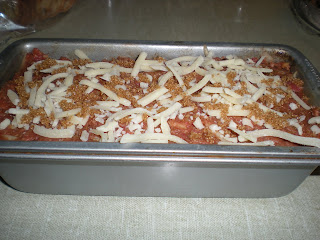Meatloaf is often thought of as boring and mundane, something you grew up eating at your mother’s kitchen table (dry and tasteless) or as “meat surprise” in school (a slice of some kind of meat topped with ketchup served on a tray with instant mashed potatoes and green beans ... where the only thing that could make the meat more edible was by covering it with more ketchup and trying not to think about what might be in it). Whether it was “Mom’s meatloaf” or the School Cafeteria variation, it rarely left a good impression!
Nowadays, you can find quite a few good meatloaf recipes floating around out there. I make meatloaf for dinner every so often, so I will have a few good recipes to experiment with and share, but this one is a variation on one of my favourite types of meatloaf to eat: Stuffed Meatloaf.
I’m not even sure where the idea for this came from, perhaps something I saw on TV somewhere (I love that show ‘Diners, Drive-Ins and Dives’) ... but it has been rolling around in my mind lately to make a meatloaf that was reminiscent of a loaded baked potato. I love loaded baked potatoes, and so I decided to try a Loaded Potato Stuffed Meatloaf.
Meatloaf, like meatballs, is rarely made with pure ground Beef. A mix of Ground Beef, combined with ground Pork and ground Veal makes the meat more tender and less dense, and adds a depth of flavour. For this recipe, you’ll make the basic meatloaf mix as per usual, with the addition of some BBQ Sauce and Bacon Bits/Chopped Bacon, but you’ll stuff it with a Potato mixture that adds some moisture, some colour, a different texture, and some interesting flavour!
Ingredients:
1 lb. Meatloaf Mix – 1/3 each of Ground Beef, Pork and Veal
1 Cup Bread Crumbs
¼ Cup Onion, chopped finely
¼ Cup Bacon Bits or Chopped Bacon
¼ Cup Parmesan Cheese, grated
¼ Cup Shredded Cheese – cheddar (optional)
¾ Cup Ketchup
¼ Cup BBQ Sauce – your favourite type
2 TB Dijon Mustard
2 tsp. Worcestershire Sauce
2 tsp. Worcestershire Sauce
1 tsp. Liquid Smoke (optional)
1 Egg (beaten)
1 Egg (beaten)
Parsley, chopped finely
Spicy Mesquite Spice Mix (I had it on hand ... I didn’t use salt or pepper in this recipe because this Spice Mix includes them both. If you don’t use this spice mix, I would add salt and pepper to taste).
1 TB Brown Sugar
2 Potatoes (I use Yukon Gold), peeled
Directions:
Combine: Ground Meat, Bread Crumbs, Onion, Bacon Bits, Parmesan cheese, Shredded Cheese, Parsley, Spicy Mesquite Spice mix in a bowl and the beaten Egg.
In another bowl, combine: Ketchup, BBQ Sauce, Mustard, Worcestershire Sauce, Liquid Smoke.
Add wet ingredients into the Beef mixture. [optional: can save 1/4 Cup for glazing]
Use your hands and make sure all ingredients are well mixed.
For the Potato Stuffing: Cut your potatoes into smaller pieces and boil for about 20 minutes until they come apart with a fork. Drain. When slightly cooled, smash them with a fork and add a pinch of salt, bacon bits, sour cream, chopped chives and shredded cheddar cheese. Mix together well to combine. [Alternatively, if you have leftover mashed potatoes, this is a great place to use them ... just add a couple of the “fixin’s” and use up your leftovers]
Now, lightly oil your meatloaf pan – it should be a shallow 7 by 10 in. pan or bread loaf tin.
Use about half the Meatloaf mixture and layer the bottom and sides of the pan, leaving a hollow ditch in the middle.
Spoon the Potato Stuffing mixture into the hollow and press gently to smooth it out.
Then layer the rest of the Meatloaf mixture on top to cover.
Brush the top gently with the reserved wet ingredients from before OR sprinkle with cheese and a touch of brown sugar.
Cover with foil and bake in a 350 degrees Fahrenheit oven for 60 – 75 minutes, or until a meat thermometer registers 170 degrees F (75 degrees C). Uncover for the last 5 minutes or so.
Let Meatloaf sit for 5 minutes before slicing and serving.
I don’t make mine with gravy because I find it is moist enough without. I usually serve with a side of steamed broccoli and/or carrots.
I find that Meatloaf reheats very well and is good in sandwiches the next day.









